
Botulinum toxin injections are among the most popular minimally invasive cosmetic treatments worldwide, which is why clear, safe advice matters.
Most people start to notice Botox in 3 to 7 days, and results last about 3 to 4 months.
This guide shows you how to make Botox last longer without gimmicks. You will get a simple plan that keeps results steady and natural through smart prep, thoughtful aftercare, and good timing.
Scope is face treatments for expression lines. It does not cover fillers or lasers. Everything here is general information, not medical advice.
If you are exploring Botox in South Mumbai, you will find a calm, practical path you can follow before, during, and after treatment. The aim is to help working readers in Mumbai and nearby areas plan care that fits tight schedules and low downtime needs.
Who should wait:
- Pregnant, breastfeeding, unwell, or skin infection at the sites
- Neuromuscular condition or past eyelid droop after toxin
- Major event in under two weeks or on blood thinners without a plan
TL;DR
- Full effect settles at about 2 weeks. Use that check to judge your result before any tweak.
- Day 0 and the first 4 hours, stay upright and hands off. Avoid rubbing or massage for 24 hours.
- Skip heavy workouts, sauna, and steam on the first day.
- Review at Day 14 if a small area needs adjustment.
- Wear sunscreen and sunglasses daily to reduce squinting.
- Plan a follow-up when movement begins to return, which for many people is between 3 and 6 months.
- Your dermatologist controls dose, map, and timing. You control first-day care, heat and exercise, skin care, sun habits, and booking rhythm.
How Botox works and why results fade
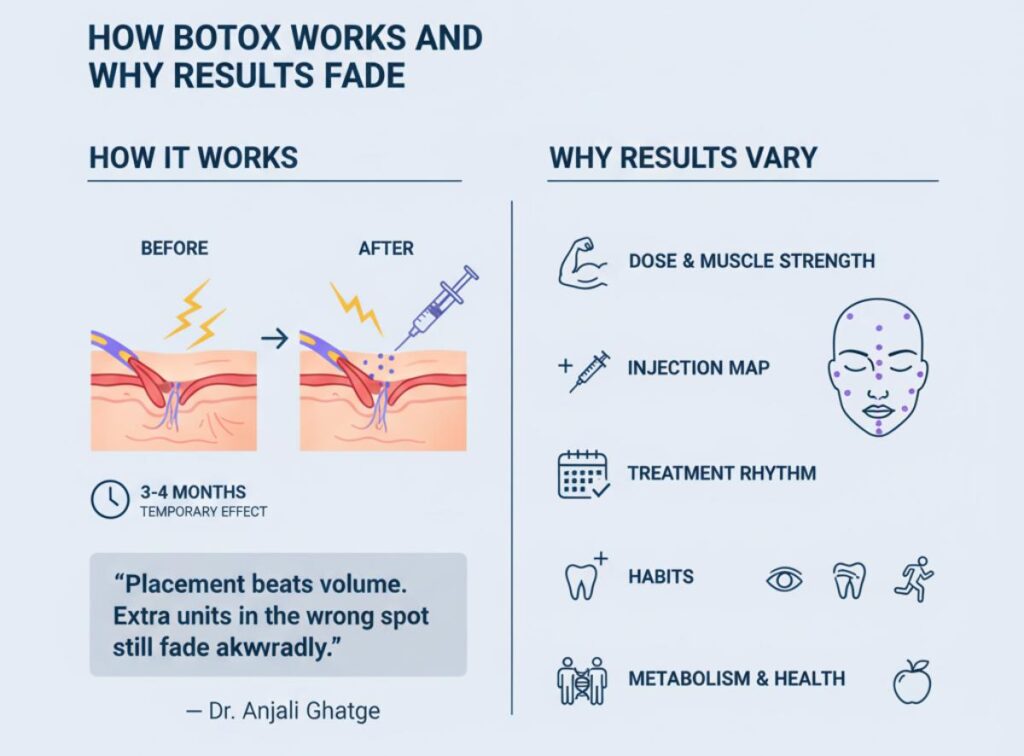
Botulinum toxin blocks the nerve signal that tells a muscle to contract. When the signal quiets, the muscle moves less and the overlying lines look softer.
Most people start to notice changes around day 3 or 4, with full effect between day 10 and 14. Results are temporary and tend to last about three to four months before movement returns.
“Placement beats volume. Extra units in the wrong spot still fade awkwardly.”
— Dr Anjali Ghatge
Why results vary from person to person
- Dose has to match muscle strength. Stronger muscles may need more units to hold a natural range.
- Injection map matters. Precise depth and spacing reduce spread to nearby muscles.
- Treatment rhythm helps. Regular sessions keep patterns steady instead of starting from scratch.
- Habits count. Frequent squinting, teeth grinding, or heavy workouts can make movement return sooner.
- Metabolism and general health play a role, which is why friends can have different timelines.
What actually controls longevity
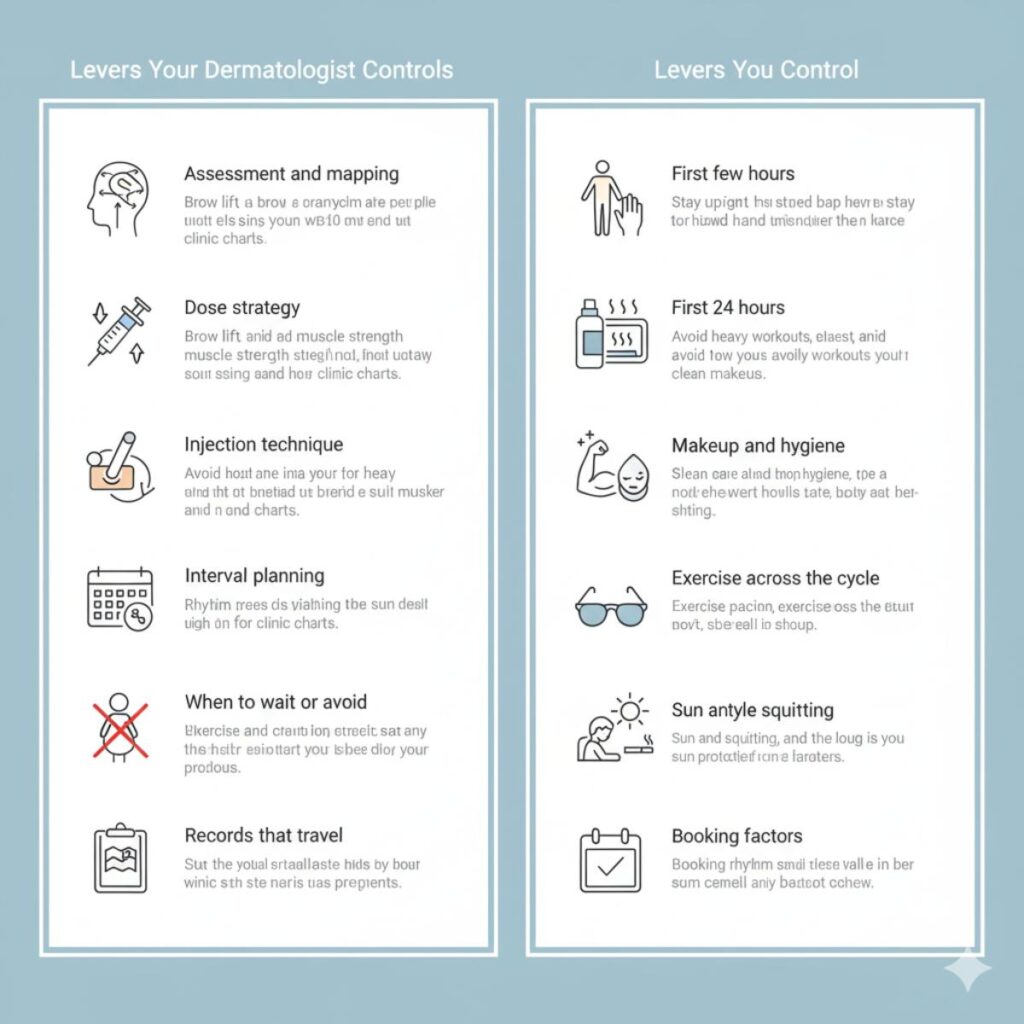
Longevity is a shared job. Your dermatologist handles mapping, dose, and timing. You handle aftercare and daily habits.
“We map before we dose so the muscle pattern, not guesswork, sets the plan.”
— Dr Anjali Ghatge
Levers your dermatologist controls
Assessment and mapping
Your plan starts with how your brows lift, how strong the frown complex is, the height of the forehead, the spread of crow’s feet, and any left-right differences. This is what keeps movement natural while softening lines, and the map evolves a little each visit.
Dose strategy
Dose matches muscle strength and the range of expression you want to keep. Stronger muscles may need more units, lighter areas less. The aim is balance, not stillness, because over-relaxing one zone can make another overwork.
Injection technique
Depth, spacing, and the angle of each point decide where product acts. Clean vectors help it reach the target muscle without drifting to neighbors. Good technique prevents odd brow lift or smile change and keeps results even through the cycle.
Interval planning
Results usually sit in a 3 to 6 month range. Plan the next visit based on the return of movement rather than a fixed calendar. Treating on a rhythm avoids starting from scratch every time, keeps photos comparable, and turns small adjustments into small injections instead of full remaps.
When to wait or avoid
Treatment is delayed if you are pregnant or breastfeeding, unwell, or have an infection at the injection site. Some neuromuscular conditions need caution. If you had a side effect last round, the plan is adjusted or paused.
Records that travel
A simple chart of sites and units per point makes the next session faster and safer. If you change clinics, sharing this map reduces trial-and-error and protects longevity.
Levers you control
First few hours
Stay upright for a few hours and keep hands off treated areas. Skip tight headwear like helmets and firm headbands. Avoid facial massage on day one so product stays where it should.
First 24 hours
Skip heavy workouts, sauna, steam, and hot yoga. Gentle walking is fine. Try back-sleep on night one so there is less pressure on the face.
Skin care timeline
Cleanse gently the same day, then leave actives out on day one. You can usually restart retinoids, exfoliating acids, vitamin C, and at-home tools after 24 to 48 hours if skin feels calm. Book facials or microneedling at least a week away from injections.
Makeup and hygiene
Light makeup after a few hours is reasonable if you use clean brushes and a soft touch. Remove it that night with lukewarm water, not heat.
Exercise across the cycle
Build back from light cardio on day two, then add strength work after a few days. Daily high-intensity sessions with little recovery can make movement return sooner for some people, so alternate hard days with easier ones.
Sun and squinting
Daily broad-spectrum sunscreen plus sunglasses reduces constant squinting. This habit does not add months, but it helps the eye area look smoother for longer and protects skin quality.
Lifestyle factors
Smoking, poor sleep, and teeth grinding fight your goals. If you clench or grind, a night guard can reduce masseter load and make the lower face plan more predictable. Keep alcohol light around treatment days to lower bruise risk.
Booking rhythm
Book your day-14 review before you leave the clinic. After that, plan your next visit when movement returns, often in the 3 to 6 month window.
A simple Botox timeline (Day 0 to Month 6)
Think of this as a rhythm. You get calm results when the first two weeks are gentle and the next three months are planned.
“Day 14 is when we make tiny corrections, not Day 2.”
— Dr Anjali Ghatge
Day 0 to hour 4
Stay upright for about four hours and keep hands off treated spots. Skip helmets, tight caps, and facial massage. Cool packs can help mild soreness if used lightly over, not rubbed into, the skin.
Day 0 to day 1
Avoid heavy workouts, sauna, and steam. A short walk is fine. Cleanse with lukewarm water. Sleep on your back the first night if you can so there is less pressure on the face.
Day 2 to day 7
Changes start to show. Let them build. Do not chase a touch-up yet because product is still settling. Keep makeup light and use clean tools. Resume gentle actives after 24–48 hours if your skin feels calm.
Day 14
This is the review point. Take photos in the same light and expression as before. If a small line still over-activates, a measured tweak can be planned now rather than earlier.
Weeks 4 to 8
Keep daily sunscreen and sunglasses to reduce squinting. Train, but give your body recovery days. Sleep and hydration help the face look its best even if they do not extend the pharmacology.
Weeks 12 to 16
When movement starts to return—commonly between 3 and 6 months—book a review so mapping stays efficient and small adjustments stay small.
If you are ready to plan your visit, Book a consultation with Dr Anjali.
Timeline at a glance
- Day 0 hands off, upright a few hours
- Day 14 peak check and small tweaks if needed
Plan the next visit when movement returns (often 3–6 months)
Before your appointment, prep that helps results
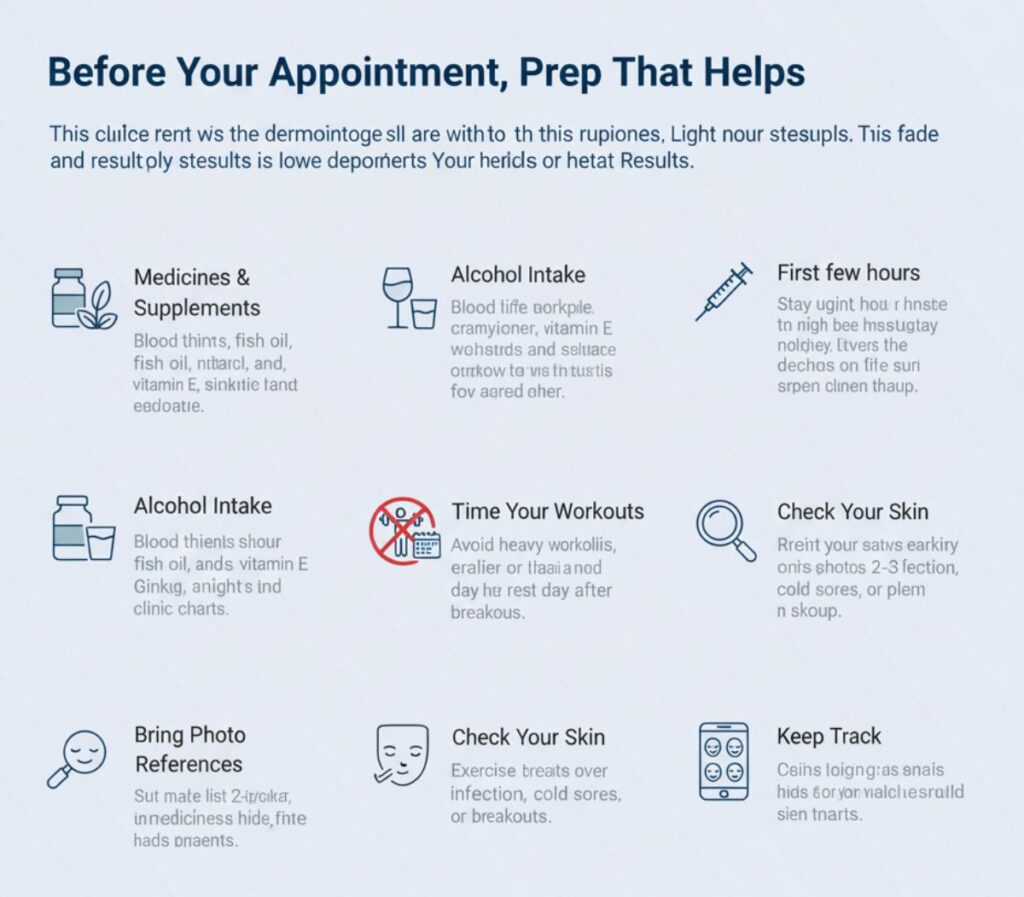
A bit of planning lowers bruise risk, keeps mapping clear, and makes the visit smoother. None of this forces a result. It just stacks the odds toward a calm, predictable start.
Tell your dermatologist about medicines and supplements you use. Blood thinners and some over-the-counter pain relievers can raise bruise risk. High-dose fish oil, vitamin E, and herbal products like ginkgo can do the same.
Do not stop anything on your own. Bring a list and decide together what to pause and what to continue.
Keep alcohol light the night before. Heavy drinking makes bruising more likely and can leave skin dehydrated, which does not help mapping. Water and a simple dinner are better choices.
Time your workouts with the visit in mind. If you train hard, do it earlier in the day, then plan a rest day after treatment. Post-injection you will skip heavy exercise for a short window, so this schedule avoids frustration and keeps pressure off fresh sites.
Check your skin. Do not treat over an active infection, cold sore, or angry breakout. If the skin is irritated at the injection site, reschedule so healing comes first. Clean, calm skin makes mapping easier.
Bring photo references. Two or three clear phone photos that show your preferred brow height and smile range help define what “natural” means for you. Add one neutral face and one laughing shot. This turns vague goals into a shared plan.
During your appointment, choices that affect longevity
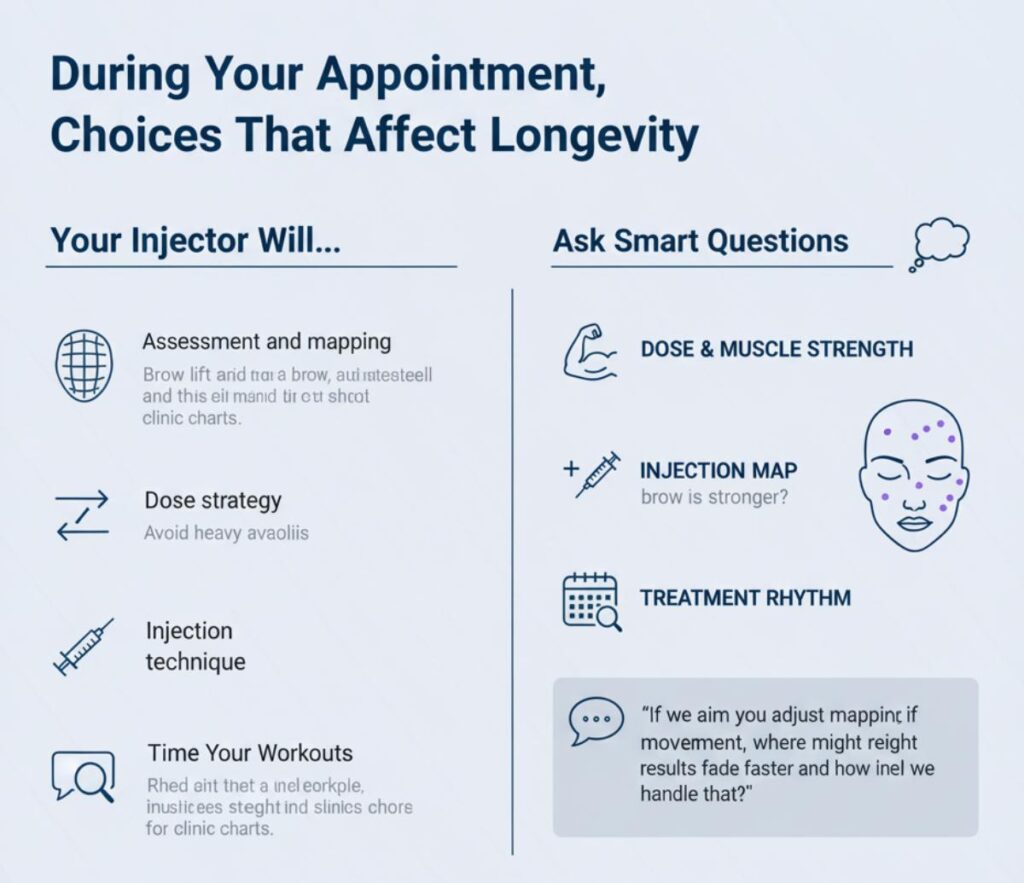
Your injector will map the whole face, not just the crease that bothers you. Balance across upper, middle, and lower face keeps movement natural.
A stronger left brow or a deeper right frown line can change the plan. Treating the muscle groups, not a single line, helps results look even through the cycle.
Be clear about expression goals. If you want softer lines with some movement, dose and sites will be lighter. If you prefer a very still look, dose and spread increase.
Each choice trades a little longevity for a little movement, or the other way around. Saying this upfront avoids “too heavy” or “not enough” later.
Some lower face muscles influence results elsewhere. Strong masseters from clenching can pull the jawline wider and change how the mid face looks. The DAO muscles tug mouth corners down and can make the chin overwork. Neck bands from the platysma can pull on the lower face. When these are active, your plan may include or avoid tiny points here so the face stays in balance.
Paperwork protects consistency. You should have consent, baseline photos in neutral and smiling views, and a simple record of sites and units. Photos taken in the same light and angle are gold at the next visit because they guide small, confident tweaks instead of guesswork.
Ask smart questions before you start
- How will you adjust mapping if my left brow is stronger?
- If we aim for natural movement, where might results fade faster and how will we handle that?
- What is the plan at day 14 if a small line persists?
These few steps turn a single visit into a steady rhythm, which is what supports longer lasting, natural looking results.
Aftercare that supports longer results
First 24 hours
For the first four hours, stay upright and keep hands off treated spots. Do not rub or massage. Skip strenuous exercise and heat sources such as sauna or steam for the first day. These steps reduce spread and bruising risk. (Source: )
Cleanse with lukewarm water and a gentle touch. If you wear makeup, apply lightly with clean tools and remove it the same night without scrubbing.
Skin care timeline
Pause actives on day 0. Retinoids, exfoliating acids, and vitamin C can usually restart at 24 to 48 hours if your skin feels calm. Book facials or microneedling at least a week away from injections so the treated areas are not pressed or manipulated. Keep massage tools, guasha, and home microcurrent off the treated zones for several days.
Heat, flights, and exercise
Avoid sauna, steam, and hot yoga for 24 hours. From day 2, add light cardio, then build back gradually. Strength work can return after a few days if the skin is settled. Long flights the same day are better avoided if you can because of prolonged pressure and rubbing while product is fresh. If travel is fixed, use a soft neck pillow and avoid pressing on the face.
A simple progression many patients find workable: Day 2 light cardio, day 4 strength, week 1 normal training.
Food, water, and supplements
Hydration, balanced protein, and regular sleep support recovery. They do not extend the pharmacology by themselves, but they help the face look its best through the cycle.
Some people ask about zinc with phytase. Early studies suggest it may modestly extend effect in some individuals, but evidence is mixed and it is not standard care. Do not start supplements without medical advice.
Collagen products have no credible evidence that they extend Botox. Use them if you like for general skin support.
Keep alcohol light for the first day to lower bruise risk.
Lifestyle habits that may shorten results
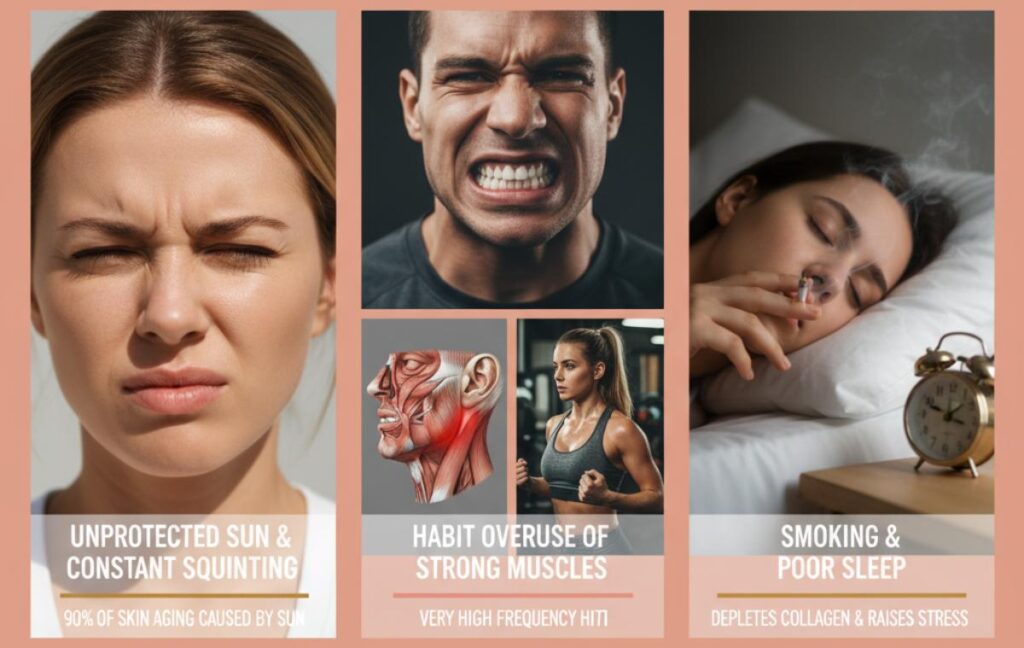
Small daily habits can nudge your timeline. Two signals matter most: how hard your facial muscles work and how your skin ages in the sun.
Unprotected sun and constant squinting
Ultraviolet exposure drives a large share of visible facial aging. Estimates suggest up to 90% of skin aging is caused by the sun, which is why sunscreen and sunglasses are daily basics, not extras .
Sunglasses cut repetitive squinting around the eyes, so lines there look smoother for longer.
Very high frequency HIIT without recovery
Max-effort training every single day can keep upper-face muscles firing and may make movement return sooner for some people. Keep hard sessions to a few days per week and give yourself recovery days. Evidence is limited, so treat this as a sensible moderation tip rather than a rule.
Smoking and poor sleep
Both work against skin quality and repair. Smoke exposure depletes collagen over time and short sleep raises stress hormones. Around treatment days, keep nights restful and avoid smoke where you can.
Habit overuse of strong muscles like the masseter
Jaw clenching and grinding build masseter size and strength, which can change how the lower face looks and how balanced the mid-face feels. Studies show parafunctional habits are linked with thicker masseter muscles, which means more pull to counter up top.
Mistakes that reduce Botox longevity
Small missteps add up. Here are the ones we see most often and how to avoid them.
Longevity is mostly planning. Clean mapping, the right units, and patient timing beat any quick fix.
Chasing the cheapest per-unit price can backfire when the dose is trimmed or the map is generic. Under-treating a strong frown complex or skipping tiny balance points creates uneven wear, so movement returns in patches. Ask how the dose matches your muscle strength and how today’s map differs from your last visit.
Touch-ups before day 14 invite uneven diffusion because the product is still settling. Early chasing often leads to a heavy feel in one area and light control in another.
Take photos in the same light and expression and review them at the two-week check instead.
Changing injectors mid-cycle without sharing your previous sites and units forces guesswork. Results may fade faster simply because the new plan is solving a puzzle from scratch. Bring a simple record or ask your last clinic for a map so small tweaks stay small.
Rubbing the area, wearing tight headwear, or lying face-down soon after treatment pushes product away from where it should act. Keep hands off for a few hours, skip helmets and firm headbands on day one, and try back-sleep the first night.
Expecting Botox to fix etched, at-rest lines from volume loss or skin texture leads to disappointment. Movement control softens expression lines. Static creases often need skin care, sunscreen, or procedures that target volume and quality. A clear plan saves units and supports steady results over the full cycle.
When Botox is not enough, smart combinations
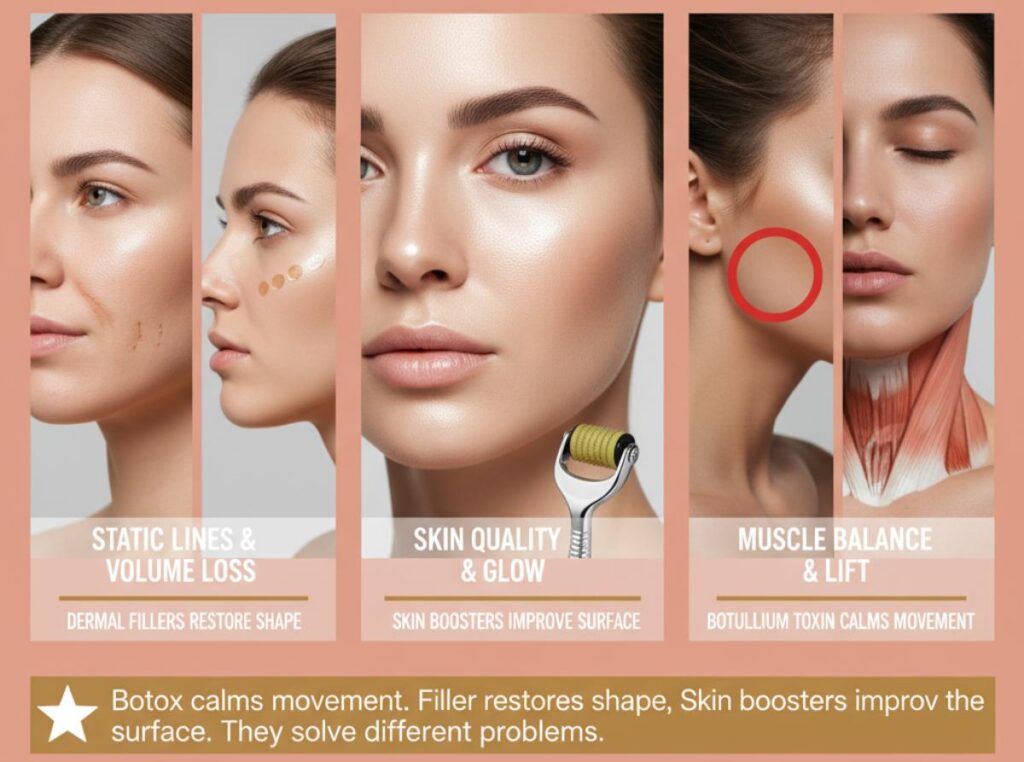
Static lines and volume loss
If a crease sits there even when your face is at rest, you are seeing a shape issue, not only movement. Adding [dermal fillers in South Mumbai] can replace gentle support in the mid face, lips, chin, or temples. Restoring structure often lets you keep a lighter, more natural Botox map instead of chasing dose.
Skin quality and glow
Fine crêpe texture and dullness are surface issues. A [skin booster treatment] with micro-droplets of hyaluronic acid can improve hydration and smoothness so lines reflect less light. Skin care and sunscreen keep those gains steady between visits.
Muscle balance or lift
Sometimes lower-face muscles change how the upper face looks. Calming a strong masseter, softening a down-pulling DAO, or treating visible neck bands can balance pull so the mid face looks calmer. Your plan may include one area now and defer others to review at day 14.
Framing the goal
Combinations do not “make Botox last” by magic. They target different causes of lines and texture so you need fewer corrections and the result looks consistent through the cycle. The right mix is conservative, photographed in the same light, and reviewed every few months, typically in the 3–6 month range.
Botox calms movement. Filler restores shape. Skin boosters improve the surface. They solve different problems.
Area by area expectations
Forehead and frown lines
Peak smoothness usually arrives near day 14, then eases back gradually over 3 to 6 months. Use sunglasses outdoors and let the brows rest in the first few days while your pattern settles.
Smooth by week two, steady by week twelve. The goal is glide, not stiffness.
Crow’s feet
This zone is busy with smiling and squinting, so movement can return here first. Daily sunscreen and good sunglasses cut squinting and help the skin look clearer for longer. Fine crinkles often show before deeper creases, which is expected.
Masseter and jawline softening
Chewing load and nighttime clenching shape how the lower face feels. If you grind, a night guard can make the plan more predictable. Changes build gradually and many patients prefer a refresh closer to 16 weeks so the jawline stays even through the cycle.
Bunny lines, lip flip, chin dimpling, neck bands
These small, expressive spots use lighter doses, so they may fade sooner than the brow. The day-14 review is where tiny, targeted tweaks keep things balanced without chasing extra units.
Side effects, safety, and red flags
Most people have a calm recovery. Mild effects can include tiny bruises, tenderness, or a short headache and they usually settle within a few days.
Less common issues include a droopy lid or brow, a lopsided smile, or a heavy neck feeling. If any of these appear, book a prompt review so mapping can be checked and adjusted.
Skip treatment today if you are pregnant, breastfeeding, unwell, or have an active skin infection at the injection site. Certain neuromuscular conditions also need specialist advice first.
Seek urgent care if you notice trouble breathing, a severe rash, or any change in vision. These are rare but important to act on without delay.
The 60 second Botox fit check
Botulinum toxin was the top minimally invasive procedure in 2023, with nearly 9.5 million treatments in the U.S., which explains why these same questions come up often.
How to use this
Tick a single box for each line. If a red flag appears, pause and speak with your dermatologist first.
Goals and expectations
- I want softer lines, not a frozen look
- I understand results build by day 14 and fade gradually over 3 to 6 months
- I am comfortable returning when movement begins to return
Safety and timing
- I am not pregnant or breastfeeding and I feel well today
- My skin is clear at the planned injection sites
- I have shared medicines and supplements that can raise bruise risk
- I can stay upright for four hours after treatment
- I can skip heavy workouts, sauna and steam for the first day
Habits that can shorten results
- I wear sunglasses outdoors and use sunscreen daily
- I can pace training with recovery days instead of daily max effort
- I do not clench or I am ready to try a night guard if I grind
Planning and follow up
- I will bring photos that show my natural brow and smile range
- I am open to small top ups only at day 14 if needed
- I will book the next visit when movement returns so mapping stays efficient
Score your check
- 10 to 13 points ticked suggests you are ready to discuss treatment and a steady plan
- 7 to 9 ticked suggests you may be ready with small tweaks or timing changes
- 6 or fewer ticked suggests you should pause and review your plan with your dermatologist
FAQs About How to Make Botox Last Longer
Two things usually drive early fade: dose and map versus muscle strength, and how active those muscles are day to day. Daily high-intensity training, frequent squinting, or jaw clenching can nudge movement back sooner. Use the plan above: wait until Day 14 for tweaks, then plan the next visit when movement returns, often in the 3–6 month range with photos to guide small changes.
Stay upright for about four hours and keep hands off treated areas. Skip tight headwear and facial massage on day one so product stays where it should. Gentle cleansing is fine. This simple window reduces rubbing and heat exposure, which are common reasons for uneven results early on.
Back-sleep is preferred on night one so there is less pressure on the face. If you turn in your sleep, do not panic. Just avoid pressing the pillow into treated spots and skip any snug sleep masks. Return to your usual position the next night if the skin feels calm.
There is no strong evidence that vitamins, collagen powders, or drinking extra water extend the pharmacology. If you are curious about supplements like zinc blends, discuss them first because data is mixed and they are not standard care. Proven basics help more: sunscreen, sunglasses, good sleep, and a steady 12–16 week booking rhythm.
You do not need to stop training. Build back with light cardio from Day 2, then strength after a few days. Daily max-effort HIIT without recovery may bring movement back sooner for some people, so alternate hard and easy days. The goal is consistency, not extremes, during the first week after treatment.
Most people find results last 3 to 6 months; time your next visit to the return of movement. Results feel more predictable over the second and third visits because mapping, dose, and photos are calibrated to your pattern. Avoid chasing touch-ups before Day 14. Bring your previous map to each visit so tiny adjustments are deliberate rather than starting from scratch.
Conclusion

At Day 30, 80% of people treated with BOTOX Cosmetic had their frown lines rated none or mild compared with 3% on placebo.
That tells you the treatment works when dose, placement, and timing line up.
Your plan is simple. Give the product time to settle. Protect the map with upright time and hands-off care. Check in at Day 14 with clear photos. Plan your next visit when movement returns, often between 3 and 6 months, so small tweaks stay small.
Use sunscreen and sunglasses so squinting is under control. If static lines or volume loss are driving what you see, add the right companion treatment instead of chasing more units.
If you want help turning this into a schedule that fits your diary and comfort level, book a consultation with Dr Anjali so we can plan your next few cycles with photos, notes, and steady results in mind.
